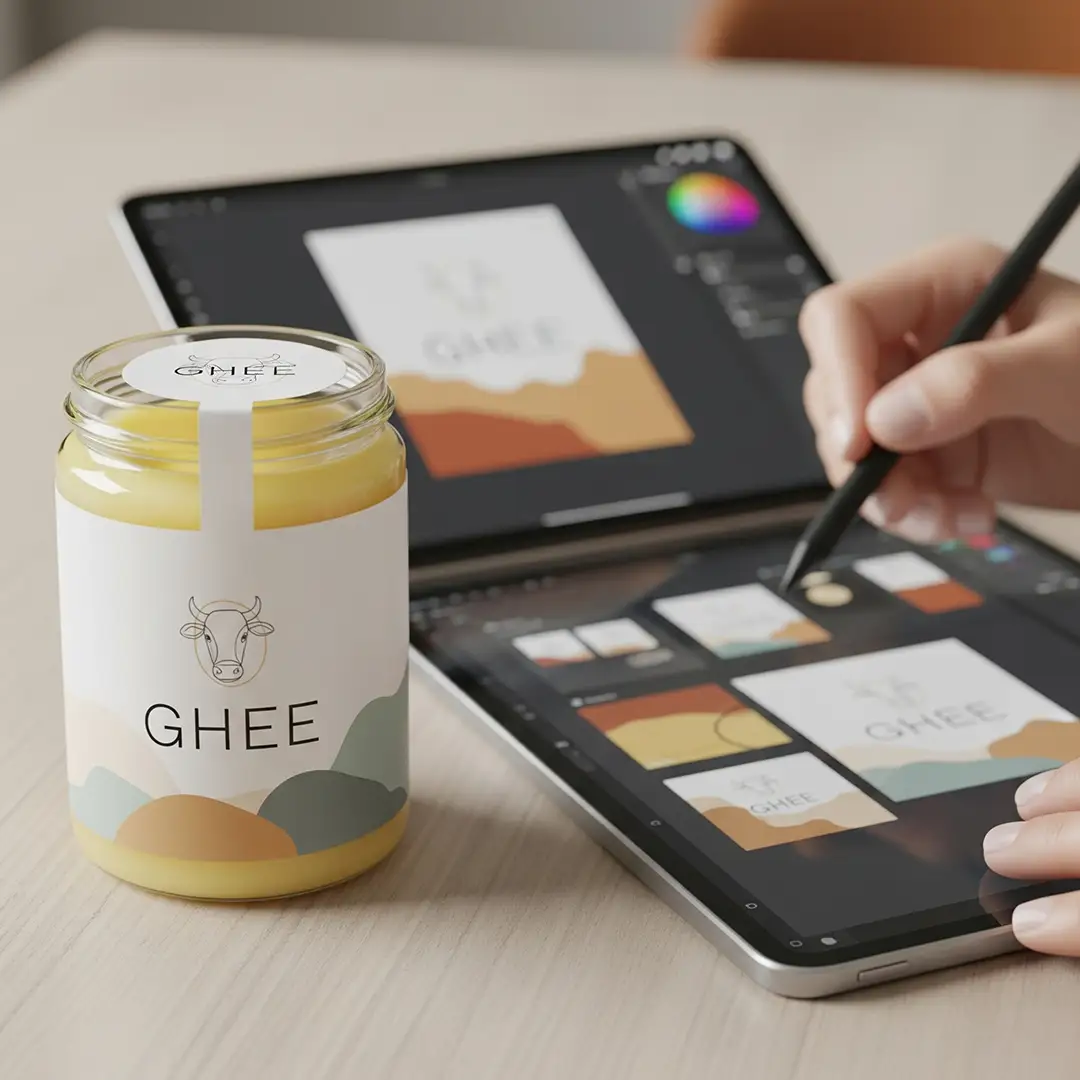Crafting a Label That Sells: A Guide to Ghee Packaging Design

In the competitive world of artisanal and health-conscious foods, a product's packaging is often its first and most important salesperson. For a product as rich in tradition and purity as ghee, the label is not just a sticker, it's a storyteller. A well-designed ghee label can communicate your brand's values, build consumer trust, and ultimately, drive sales.
Here’s a guide to creating a ghee label that stands out on the shelf and resonates with your target audience.
1. Know Your Brand and Your Audience
Before you even think about colours or fonts, you need to define your brand's core identity. Are you a brand that emphasizes traditional, artisanal methods or one that focuses on modern, organic, and clean-label qualities? The answer will guide every design decision.
- For a Traditional or Heritage Brand: Consider using earthy colour palettes (deep reds, regal golds, and browns), and incorporating traditional motifs, patterns, or images of cows in a pastoral setting. Ornate and classic typography can further reinforce a sense of heritage and authenticity.
- For a Modern or Organic Brand: A minimalist and clean design is often the most effective. Use a limited, sophisticated colour palette and clean lines. Simple, elegant fonts and uncluttered layouts can convey a sense of premium quality and purity.
2. Essential Elements of Your Ghee Label
Every effective ghee label must contain several key pieces of information, strategically placed to catch the consumer's eye.
- Prominent Logo and Brand Name: Your logo and brand name should be the first thing a customer sees. Their placement and design should be strategic, instantly helping consumers recognize your product among many others.
- Clear Product Information: Be concise and clear. The label should immediately tell the consumer what the product is (e.g., "Organic Grass-Fed Cow Ghee"), its size, and any unique selling points, such as its nutrient content or specific production method (e.g., "Hand-churned Bilona Ghee").
- Regulatory Compliance: Ensure your label meets all local and national food safety and labeling regulations. This includes displaying nutritional information, ingredients, and the manufacturing and expiration dates. This not only keeps you compliant but also builds essential consumer trust through transparency.
3. The Power of Visuals: Colours, Typography, and Imagery
The aesthetic choices you make on your label can create a powerful emotional connection with the consumer.
- Colours: The colour palette should align with your brand story. Yellows and golds evoke the colour of ghee itself and symbolize richness and warmth. Greens and light blues can convey a sense of purity and natural origin, especially for organic brands.
- Typography: The font you choose speaks volumes. A graceful, traditional script can evoke a sense of craftsmanship and tradition, while a bold, clear sans-serif font can communicate modernity and clarity. Ensure the font is legible, even from a distance.
- Imagery: Images can tell your brand's story at a glance. A graceful silhouette of a cow, a simple icon of a churning pot, or a rustic village scene can communicate heritage and authenticity. For modern brands, a single, elegant illustration or a simple pattern can be more effective.
4. Choosing the Right Packaging Material
The label design is often influenced by the packaging container itself. The material you choose also communicates a certain message to the consumer.
- Glass Jars: These convey a premium, high-quality, and traditional feel. Glass is also an excellent barrier to light and air, which helps preserve the ghee's freshness. However, they are heavier and more fragile for transport.
- Plastic (PET/HDPE): Plastic is lightweight, durable, and cost-effective. PET is transparent, which allows the product's golden colour to be showcased, while HDPE provides better chemical resistance.
- Flexible Pouches or Tin Cans: Pouches are an economical and convenient option, often used for larger quantities. Tin cans are excellent for long-term storage and bulk packaging, and their sturdy nature makes them ideal for safe transport.
The Future of Ghee Labelling
As consumer preferences evolve, so too do labelling trends. Sustainability is a growing concern, leading to a demand for eco-friendly labelling materials and biodegradable inks. "Smart labels" with QR codes are also on the rise, allowing customers to scan the label with their phones to access detailed information about the product's origin, nutritional benefits, and even recipe ideas, further enhancing transparency and trust.
By thoughtfully considering your brand, audience, and the key design elements, you can create a ghee label that not only protects your product but also communicates its quality and story, turning a simple jar into a brand ambassador.